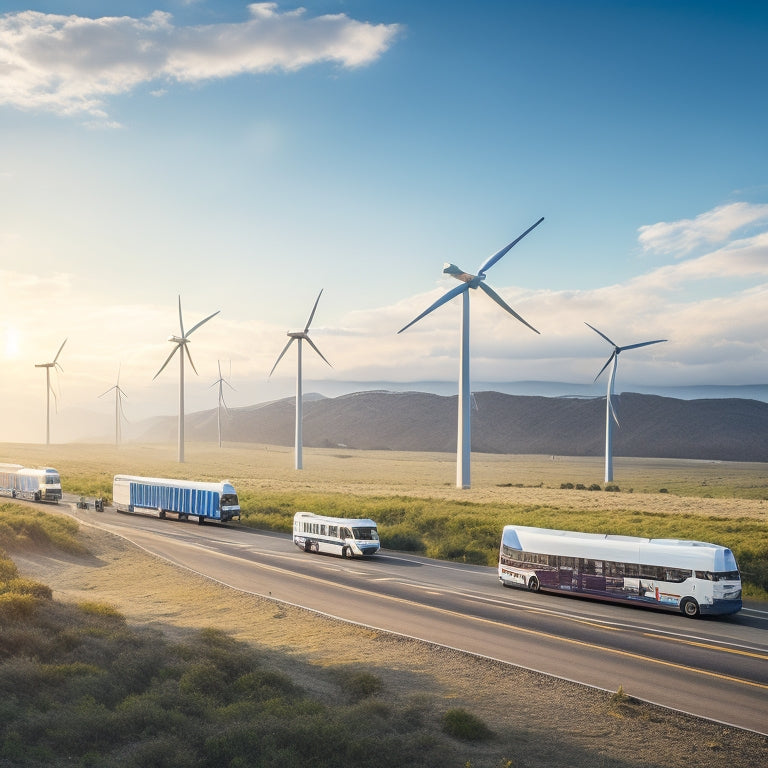
Powering Fleets With Renewable Energy Solutions
Share
You're seeking ways to shift your fleet to renewable energy solutions, reducing your carbon footprint and operating costs. You're not alone - with the transportation sector accounting for nearly 27% of total greenhouse gas emissions in the US. Harnessing solar power, installing solar panels on trucks, and implementing electric vehicle charging infrastructure can notably decrease your reliance on fossil fuels. Plus, you can tap into government incentives for electric vehicles and reap cost savings. Explore the benefits of renewable energy adoption and discover a path to sustainable fleet operations that's good for the planet and your bottom line.
Key Takeaways
• Fleets can harness solar power through solar farms and installed solar panels on trucks to maximize energy output and reduce carbon footprint.
• Implementing electric vehicle charging infrastructure and government incentives for electric vehicles can accelerate the transition to renewable energy.
• Renewable energy adoption can lead to significant cost savings, improved operational efficiency, and enhanced environmental impact for fleets.
• Incentives such as federal, state, and local credits are available for fleets embracing renewable energy solutions, providing a competitive edge in the market.
• By adopting renewable energy solutions, fleets can contribute to a more sustainable future, reduce reliance on fossil fuels, and promote energy independence.
Harnessing Solar Power for Fleets
As you explore ways to electrify your fleet, consider harnessing solar power to reduce your reliance on fossil fuels and lower operating costs.
Solar farms, also known as solar parks, are large-scale photovoltaic systems that convert sunlight into electricity. By investing in solar farms, you can generate clean energy and reduce your carbon footprint.
Energy harvesting from solar farms can be an effective way to power your fleet, especially for operations with high energy demands.
When evaluating solar farms for your fleet, consider the size and location of the farm, as well as the type of photovoltaic technology used. It's essential to assess the energy output and transmission infrastructure to ensure a reliable supply of clean energy.
Additionally, consider partnering with solar farm developers or energy companies to secure a stable and cost-effective energy supply.
Benefits of Renewable Energy Adoption
By embracing renewable energy solutions like solar power, you can access numerous benefits that extend beyond reducing your carbon footprint, including significant cost savings and improved operational efficiency. Renewable energy adoption can lead to energy independence, reducing your reliance on fossil fuels and mitigating the risks associated with price volatility. This, in turn, can lead to improved budget predictability and a competitive edge in the market.
Some key benefits of renewable energy adoption include:
-
Energy Independence: By generating your own clean energy, you can reduce your reliance on external energy sources, ensuring a stable and predictable energy supply.
-
Rural Development: Renewable energy solutions can be particularly beneficial for rural areas, where access to energy infrastructure may be limited.
-
Improved Operational Efficiency: Renewable energy solutions can help optimize your fleet's operations, reducing downtime and increasing overall productivity.
Reducing Carbon Footprint in Logistics
As you work to reduce your fleet's carbon footprint, you'll need to develop a thorough strategy that incorporates green logistics strategies, outlines a clear emissions reduction roadmap, and prioritizes sustainable fleet operations.
By doing so, you'll be able to greatly minimize your environmental impact while also cutting costs and improving operational efficiency.
Green Logistics Strategies
You can greatly reduce your company's carbon footprint by implementing green logistics strategies that prioritize sustainability and efficiency in every stage of the logistics process. By adopting green logistics strategies, you can minimize your environmental impact while also reducing costs and improving your bottom line.
Here are some key strategies to consider:
-
Optimize routes and schedules: By optimizing routes and schedules, you can reduce fuel consumption, lower emissions, and decrease the number of vehicles on the road.
-
Implement a green supply chain: Adopt sustainable practices throughout your supply chain, such as sourcing materials locally, reducing packaging waste, and using eco-friendly packaging materials.
-
Invest in carbon offset programs: Offset your carbon emissions by investing in renewable energy projects, reforestation efforts, or other carbon-reducing initiatives.
Emissions Reduction Roadmap
Developing an emissions reduction roadmap is critical to reducing your logistics operation's carbon footprint, as it provides a clear plan of action to achieve specific sustainability goals. This roadmap serves as a guide for your organization to navigate the journey towards a more environmentally friendly fleet.
By setting concrete Climate Targets, you can create a sense of urgency and direction, ensuring that your efforts are focused on meaningful reductions in greenhouse gas emissions.
A well-structured roadmap will also help you stay compliant with the evolving Regulatory Framework, which is increasingly emphasizing emissions reduction. By understanding the current regulatory landscape and anticipating future developments, you can make informed decisions that support both business growth and environmental sustainability.
Your emissions reduction roadmap should identify key milestones, timelines, and responsible parties, ensuring that everyone involved is working towards the same objectives.
With a clear roadmap in place, you'll be better equipped to measure progress, identify areas for improvement, and make data-driven decisions that drive meaningful change.
Sustainable Fleet Operations
By adopting sustainable fleet operations, your logistics operation can greatly reduce its carbon footprint, minimizing environmental impact while optimizing resource allocation. This not only benefits the environment but also helps you stay competitive in the industry.
To achieve sustainable fleet operations, consider the following strategies:
-
Fleet Optimization: Implement telematics and data analytics to optimize routes, reduce idle times, and improve driver behavior. This can lead to significant reductions in fuel consumption and emissions.
-
Supply Chain Collaboration: Collaborate with suppliers and partners to reduce transportation costs, lower emissions, and increase efficiency.
-
Alternative Fuels and Vehicles: Explore the use of alternative fuels, electric vehicles, or hybrid vehicles for your fleet, reducing dependence on fossil fuels and minimizing emissions.
Solar Panel Installation for Trucks
Solar panels can be effectively installed on trucks to harness the sun's energy and recharge onboard batteries, reducing idle time and associated emissions.
When considering solar panel installation for your truck, you'll want to optimize panel efficiency to maximize energy output.
A truck bed or roof mount installation can provide the necessary surface area for solar panels, guaranteeing a seamless integration with your cabin's electrical system.
This setup not only reduces emissions but also enhances driver safety by minimizing idle time, which decreases the risk of accidents and improves overall fleet safety.
To guarantee a successful installation, assess your energy needs and select high-efficiency panels that can withstand the demands of trucking operations.
Electric Vehicle Charging Infrastructure
As you electrify your fleet, you'll need to invest in a robust electric vehicle charging infrastructure that can efficiently support your vehicles' power needs. A well-designed charging infrastructure is important to ensure your fleet operates smoothly and safely.
To achieve this, you should consider the following key aspects:
-
Charging Station Design: Make sure your charging stations are designed with safety in mind, providing ample space for vehicles to maneuver and charge efficiently.
-
Vehicle to Grid Technology: Leverage Vehicle to Grid (V2G) technology to enable your electric vehicles to act as energy storage devices, feeding energy back into the grid when not in use.
-
Scalability and Flexibility: Design your charging infrastructure to be scalable and flexible, allowing you to adapt to growing demands and new technologies as they emerge.
Fleet Management With Green Technology
As you shift your fleet to renewable energy, you'll want to explore electric vehicle incentives that can help offset the costs of upgrading your fleet.
You'll also need to develop green fleet strategies that prioritize sustainability and minimize environmental impact.
Electric Vehicle Incentives
You can greatly decrease the cost of switching your fleet to electric vehicles by taking advantage of federal, state, and local incentives, which can provide substantial rebates, tax credits, and exemptions. These incentives can notably reduce the upfront cost of adopting electric vehicles, making them a more viable option for your fleet.
Some of the government subsidies and tax breaks you can take advantage of include:
-
Federal Tax Credit: Up to $7,500 per vehicle
-
State Incentives: Rebates and credits ranging from $1,000 to $5,000 per vehicle
-
Local Incentives: Exemptions from traffic congestion fees, tolls, and parking fees
Green Fleet Strategies
Implementing green fleet strategies requires integrating eco-friendly technologies and sustainable practices into your fleet's operations to minimize environmental impact and reduce costs. By adopting green fleet strategies, you can reduce your carbon footprint, lower emissions, and save on fuel expenses. This can be achieved through various means, including:
| Strategy | Description |
|---|---|
| Carbon Pricing | Internal carbon pricing helps you track and manage your fleet's carbon emissions, facilitating a more sustainable operation. |
| Fleet Innovations | Adopting electric or hybrid vehicles, and exploring alternative fuels, can noticeably reduce your fleet's environmental impact. |
| Route Optimization | Optimizing routes and schedules can reduce fuel consumption, lower emissions, and improve overall efficiency. |
| Vehicle Maintenance | Regular maintenance and timely repairs can improve fuel efficiency, reduce waste, and extend vehicle lifespan. |
| Driver Training | Educating drivers on eco-friendly driving practices can lead to noteworthy reductions in fuel consumption and emissions. |
Sustainable Operations Planning
By integrating green technology into your fleet management, you can streamline operations, reduce waste, and improve overall sustainability. This is achieved through sustainable operations planning, which involves optimizing your fleet's daily activities to minimize environmental impact.
To achieve this, you can implement the following strategies:
-
Route Optimization: Use advanced algorithms to plan the most fuel-efficient routes, reducing fuel consumption and lowering emissions.
-
Supply Chain Optimization: Analyze and optimize your supply chain to reduce transportation needs, lower inventory levels, and minimize waste.
-
Inventory Management: Implement just-in-time inventory management systems to reduce inventory levels, lower storage needs, and minimize waste.
Overcoming Range Anxiety in EVs
Range anxiety, a pervasive concern among electric vehicle (EV) adopters, stems from the uncertainty surrounding the availability of charging infrastructure and the limited driving range of EVs. As you consider shifting your fleet to electric, understanding the psychological factors driving range anxiety is pivotal. EV psychology plays a significant role in shaping your charging habits.
You may find yourself worrying about running out of charge before reaching a charging station, leading to a pattern of frequent, short trips to recharge. However, this behavior can lead to reduced efficiency and increased energy consumption.
To overcome range anxiety, it's important to develop a deeper understanding of your charging habits. You can start by tracking your daily driving patterns, identifying areas with limited charging infrastructure, and planning your routes accordingly. By doing so, you'll be able to better estimate your energy needs and adjust your charging schedule to minimize anxiety.
Additionally, staying informed about the expansion of charging infrastructure and advancements in EV technology can help alleviate concerns. By addressing the psychological and practical aspects of range anxiety, you can confidently shift your fleet to electric and reap the benefits of renewable energy.
Solar Energy for Truck Stops
As you consider integrating solar energy into truck stops, you'll need to evaluate the charging station infrastructure required to support your fleet's needs.
You'll also need to assess the energy storage systems necessary to guarantee a reliable power supply.
Charging Station Infrastructure
You'll likely need to prioritize the installation of high-power charging stations at strategic locations, such as truck stops, to support the seamless adoption of electric fleets. This infrastructure is vital for facilitating the shift to renewable energy solutions.
When designing your charging station infrastructure, consider the following key factors:
-
Station Design: Make sure that your charging stations are equipped with multiple charging points, high-power charging capabilities, and adequate parking spaces to accommodate large vehicles.
-
Urban Planning: Strategically locate your charging stations in areas with high traffic volume, such as near highways, to maximize accessibility and convenience for fleet operators.
-
Safety Features: Implement safety features, such as surveillance cameras, emergency response plans, and secure payment systems, to guarantee a safe and secure charging experience for users.
Energy Storage Systems
To maximize the benefits of renewable energy solutions for fleets, consider integrating energy storage systems, such as solar energy, into truck stops to reduce reliance on the grid and mitigate power outages. By doing so, you'll enhance grid resiliency, ensuring a stable and reliable energy supply for your fleet.
Energy storage systems, like advanced battery technologies, play an important role in optimizing energy usage and reducing strain on the grid.
Incorporating energy storage systems into truck stops enables you to store excess energy generated from solar panels during the day, which can be utilized during periods of high demand or when the grid is experiencing outages. This approach not only reduces your reliance on the grid but also provides a backup power source, ensuring your fleet remains operational during outages.
Recent battery innovations have made energy storage systems more efficient, cost-effective, and environmentally friendly. By adopting these innovations, you'll be well on your way to creating a more resilient and sustainable energy infrastructure for your fleet.
Solar Panel Installations
By integrating solar panel installations into truck stops, you can harness the power of solar energy to fuel your fleet, reducing reliance on the grid and mitigating the impact of power outages. This innovative approach enables you to generate clean energy on-site, reducing your carbon footprint and operating costs.
To maximize energy harvesting, consider the following strategies:
-
Optimize roof space: Install solar panels on the truck stop's roof to create a solar roof, generating energy while minimizing land use.
-
Select high-efficiency panels: Choose solar panels with high energy conversion rates to maximize energy production per unit area.
-
Monitor and maintain: Regularly inspect and upkeep your solar panel installation to guarantee top performance and extend its lifespan.
Cost Savings With Renewable Energy
Switching to renewable energy sources can greatly reduce your fleet's operating expenses, as electricity generated from solar or wind power often costs less than traditional fossil fuels. By adopting renewable energy, you can substantially cut down on fuel costs, which can be a substantial portion of your fleet's operational expenses. This, in turn, can lead to improved fuel efficiency, allowing your fleet to travel farther on a single unit of energy.
Conducting regular energy audits can help you identify areas where energy is being wasted and provide opportunities for improvement. By optimizing your energy usage, you can reduce your fleet's carbon footprint while also saving on energy costs.
Additionally, many governments offer incentives and tax credits for fleets that embrace renewable energy solutions, further reducing the costs associated with embracing clean energy. By making the switch to renewable energy, you can enjoy significant cost savings while also contributing to a more sustainable future.
Future of Sustainable Fleet Operations
As you look to the future, you'll need to adapt your fleet operations to meet increasingly stringent emissions regulations and rising consumer expectations for sustainability. The writing is on the wall: fleet electrification is no longer a nicety, but a necessity.
To stay ahead of the curve, consider the following strategies:
-
Fleet Electrification: Invest in electric vehicles (EVs) and charging infrastructure to reduce your carbon footprint and operating costs.
-
Supply Chain Optimization: Collaborate with suppliers to reduce emissions throughout the entire value chain, from procurement to delivery.
-
Data-Driven Decision Making: Leverage telematics and data analytics to optimize routes, reduce idle time, and improve overall fleet efficiency.
Frequently Asked Questions
What Is the Average ROI on a Solar Panel Installation for Fleets?
You can expect an average ROI of 12-15% on a solar panel installation for fleets, driven by energy savings and favorable financial projections, ensuring a safe and profitable investment for your fleet operations.
Can Renewable Energy Solutions Integrate With Existing Fleet Management Systems?
You'll be relieved to know that renewable energy solutions can seamlessly integrate with your existing fleet management systems, leveraging fleet analytics and data integration to guarantee a smooth, safe, and efficient shift.
How Do Weather Conditions Impact the Efficiency of Solar Panels on Trucks?
As you navigate the open road, you wonder how weather conditions impact solar panels on trucks. On cloudy days, energy output dwindles, while hot road temperatures can reduce efficiency by up to 1.5%.
Are There Any Government Incentives for Adopting Renewable Energy in Fleets?
You may be eligible for tax credits and state rebates when adopting renewable energy in your fleet, such as installing solar panels, which can greatly reduce your upfront costs and boost your return on investment.
Can Electric Vehicles Be Charged Using Renewable Energy Sources On-Site?
You can charge electric vehicles using on-site renewable energy sources, like solar or wind power, with energy storage solutions ensuring a stable supply, provided your fleet's vehicles are compatible with the charging infrastructure.
Related Posts
-

7 Best Cool Roof Rebates for Energy-Savvy Homeowners
You're an energy-savvy homeowner looking to install a cool roof, and you're wondering which rebates can help you save...
-

3 Earth-Loving Furniture Tips for Energy-Smart Homes
When furnishing your energy-smart home, you have the power to reduce your carbon footprint greatly by making consciou...
-

What Air Purifiers Save Energy in Work Areas?
You can cut energy costs and reduce your carbon footprint by choosing air purifiers designed with energy efficiency i...


